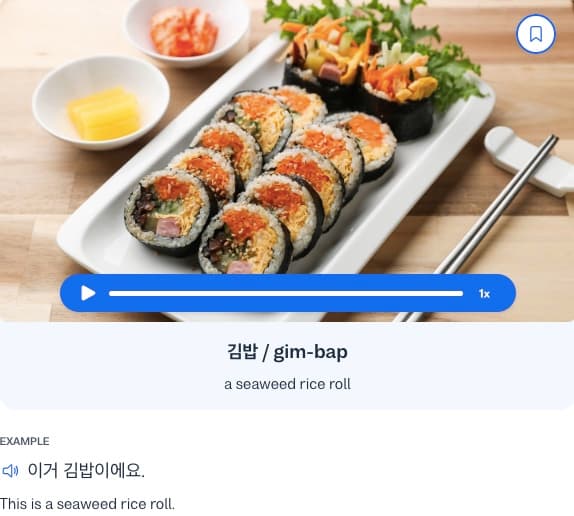Food in Korean: Useful Vocabulary to Know
Learn the important vocabulary so you can talk about different types of food in Korean.
Author:

Keehwan Kim
The popularity of Korean food is growing every day. People all over the world are enjoying the rich flavors at Korean barbecue restaurants, trying Korean street food like 떡볶이 (Tteokbokki, spicy rice cake), and eating spicy instant noodles like 신라면 (Shin Ramyun). However, Korean food has so much more to offer, and in this article, we are going to take you on a guided tour of traditionalfood in Korean. We’ll teach you useful words to talk about different types of ingredients, vegetables, fruit, drinks andtraditional food in Korean.
Talking about main meals in Korean
The Korean word for food is 음식 (eumsik). It is a general word for food and it can be used to talk about all types of food in Korean.
To refer to different meals throughout the day, we can use the words 아침, 점심 and 저녁.
Names of Korean main meals
| Korean | Pronunciation | English |
|---|---|---|
| 보리 | [barley] | barley |
| 기장 | [gi-jang] | proso millet |
| 콩 | [kong] | dinner |
| 조 | [jo] | foxtail millet |
Soups in Korean: 국, 탕, 찌개
Korean meals are almost always accompanied by a soup dish. Most often, a person would be served his or her own soup alongside their 밥 (rice). There are also times where a large soup is served so that it can be shared with others. There are three types of soup dishes.
국 [guk]
국 [guk] is the most common soup dish in Korea. 국 has a lot of soup and it contains some solid ingredients, such as meat and vegetables. We mainly eat 국 for the broth, rather than the solid ingredients. In general, 국 is served individually and it’s regarded as a dish that served the rice, so it’s usually served in a small bowl. Below are some common types of 국.
Common 국 soup dishes in Korean
| Korean | Pronunciation | Description |
|---|---|---|
| 미역국 | [mi-yeok-guk] | Soup made with kelp |
| 김치국 | [kim-chi-guk] | Soup made with kimchi |
| 콩나물국 | [kong-na-mul-guk] | Soup made with soybean sprout |
| 북어국 | [bu-geo-guk] | Soup made with dried pollack |
탕 [tang]
탕 [tang] is similar to 국 as it contains a lot of soup, but the soup is often made by boiling for a long period, which results in a thicker soup than 국. 탕 is generally served individually and it’s often served in a large bowl as the main meal. Below are some common types of 탕.
Common 탕 soup dishes
| Korean | Pronunciation | Description |
|---|---|---|
| 갈비탕 | [gal-bi-tang] | Soup made with beef ribs |
| 삼계탕 | [sam-gye-tang] | Soup made with chicken |
| 설렁탕 | [seo-leong-tang] | Soup made with ox bone |
| 대구탕 | [dae-gu-tang] | Soup made with cod |
찌개 [jji-gae]
The major difference between 찌개 and the other types of soup is that 찌개 has less water and it has a lot of solid ingredients. So people eat 찌개 for its broth but also for its solid ingredients. 찌개 can be served individually, but it’s more commonly shared by diners. Below are some common types of 찌개.
Common 찌개 soup dishes
| Korean | Pronunciation | Description |
|---|---|---|
| 된장찌개 | [doen-jang-jji-gae] | Soup made with soybean paste, and often contains clam and tofu |
| 김치찌개 | [kim-chi-jji-gae] | Soup made with kimchi, and often contains tofu and pork |
| 동태찌개 | [dong-tae-jji-gae] | Soup made with pollock, and often contains tofu |
| 부대찌개 | [bu-dae-jji-gae] | Spicy soup dish that contains various ingredients, such as kimchi, sausage, ham, and tofu |
Korean main dishes
Korean meals are often served with a main dish which is shared with other diners. These main dishes are often made with different kinds of fish and meat. Meat in Korean is 고기 [go-gi], and to refer to different kinds of meat, we add the name of the animal in front of 고기. For example, ‘pig’ in Korean is 돼지 [dwae-ji], so ‘pork’ is 돼지고기.
Names of meat in Korean
| Korean | Pronunciation | English |
|---|---|---|
| 돼지고기 | [dwae-ji-go-gi] | pork |
| 소고기 | [so-go-gi] | beef |
| 닭고기 | [dak-go-gi] | chicken |
| 양고기 | [yang-go-gi] | lamb |
| 소시지 | [so-si-ji] | sausage |
| 베이컨 | [be-i-keon] | bacon |
Fish in Korean is 생선 [saeng-seon], but we actually have two words for fish. One is 생선 and we use this word to refer to fish that has been caught for food. So when we see fish for sale in the supermarket, or when we refer to fish on the dining table, we refer to that fish as 생선. The other word is 물고기 [mul-go-gi], and we use this word to refer to fish swimming in the water, whether it be the river or the sea. Below are some common fish eaten in Korea.
Names of fish in Korean
| Korean | Pronunciation | English |
|---|---|---|
| 고등어 | [go-deung-eo] | mackerel |
| 대구 | [dae-gu] | cod |
| 조기 | [jo-gi] | croaker |
| 꽁치 | [kkong-chi] | saury |
| 가자미 | [ga-ja-mi] | plaice |
| 광어 | [gwang-eo] | halibut |
| 장어 | [jang-eo] | eel |
As different kinds of meat and fish are made into certain dishes, they can take on different names, such as 대구탕 (cod soup). Below are some common main dishes made with different kinds of meat and fish.
Common traditional food in Korean
| Korean | Pronunciation | Description |
|---|---|---|
| 닭도리탕 | [dak-do-ri-tang] | spicy braised chicken with soup |
| 갈비찜 | [gal-bi-jjim] | braised short ribs |
| 고등어조림 | [go-deung-eo-jo-rim] | braised mackerel |
| 꽁치구이 | [bu-dae-jji-gae] | grilled saury |
A lot of main dish names end with words that describe what that dish is like, or how that dish is cooked.
탕 as we learned before refers to soup-based dishes.
찜 refers to dishes that made by steaming the food
조림 refers to dishes that are made by braising the food
구이 refers to food that has been grilled.
Side dishes in Korean: 반찬
Korean meals are often served with many side dishes, and these side dishes are shared with other diners. Elaborate meals can have more than 10 side dishes, while a simple meal at home can have 3 to 5 side dishes. The most common side dish is 김치 (kimchi).
김치 [kim-chi]
김치 is the famous side dish, and there are many different types of 김치. The most common is made with 배추 [bae-chu], napa cabbage, and because it is fermented, it is high in probiotics.
Common types of 김치 side dishes in Korean
| Korean | Pronunciation | English |
|---|---|---|
| 배추김치 | [bae-chu-kim-chi] | napa cabbage kimchi |
| 총각김치 | [chong-gak-kim-chi] | ponytail radish kimchi |
| 오이소박이 | [o-i-so-ba-gi] | cucumber kimchi |
| 파김치 | [pa-kim-chi] | scallion kimchi |
| 깍두기 | [kkak-du-gi] | cubed radish kimchi |
| 백김치 | [baek-kim-chi] | white kimchi |
| 동치미 | [dong-chi-mi] | radish water kimchi |
Korean vegetables 나물 [na-mul]
나물 refers to seasoned vegetables. 나물 can be made with many different kinds of vegetables, many of which grow in the wild, and they are often made by boiling or frying them and then seasoning them with various spices and sesame oil. Many 나물 dish names end in 무침 [mu-chim] which means seasoned.
Common types of 나물무침 Korean vegetables
| Korean | Pronunciation | English |
|---|---|---|
| 시금치무침 | [shi-geum-chi-mu-chim] | seasoned spinach |
| 고사리무침 | [naeng-i-mu-chim] | seasoned bracken |
| 쑥무침 | [go-sa-ri-mu-chim] | seasoned mugwort |
| 미나리무침 | [mi-na-ri-mu-chim] | seasoned dropwort |
| 달래무침 | [dal-rae-mu-chim] | seasoned pickled-peel garlic |
볶음 [bo-kkeum]
뽁음 simply means ‘fried’, and it refers to various stir-fried side dishes. One of the most common side dishes is 김치볶음 (fried kimchi), but there are many different types of 볶음 side dishes.
Common types of 볶음 side dishes
| Korean | Pronunciation | English |
|---|---|---|
| 김치볶음 | [kim-chi-bo-kkeum] | stir-fried kimchi |
| 두부볶음 | [du-bu-bo-kkeum] | stir-fried tofu |
| 버섯볶음 | [beo-seot-bo-kkeum] | stir-fried mushroom |
| 미역줄기볶음 | [my-yeok-jul-gi-bo-kkeum] | stir-fried seaweed stem |
| 콩나물볶음 | [kong-na-mul-bo-kkeum] | stir-fried bean sprout |
젓갈 [jeot-gal]
젓갈 refers to salted seafood. Salted seafood can be made with various fish and seafood, such as anchovies, clams, and shrimps, but it can also be made with various fish roe. 젓갈 is very salty, and we usually eat a small amount at a time. When we refer to different types of 젓갈, we often refer to them as just 젓.
Common types of 젓갈 salted seafood
| Korean | Pronunciation | English |
|---|---|---|
| 새우젓 | [sae-woo-jeot] | salted shrimp |
| 조개젓 | [jo-gae-jeot] | salted clam |
| 멸치젓 | [myeol-chi-jeot] | salted anchovies |
| 명란젓 | [myeong-ran-jeot] | salted pollack roe |
| 오징어젓 | [o-jing-eo-jeot] | salted squid |
Below are some other common side dishes in Korea
Other traditional side dishes in Korea
| Korean | Pronunciation | English |
|---|---|---|
| 김 | [kim] | dried seaweed |
| 깻잎 | [kkaen-nip] seasoned sesame leaf | seasoned sesame leaf |
| 두부조림 | [du-bu-jo-rim] | braised tofu |
| 계란찜 | [gye-ran-jjim] | steamed egg |
| 소고기 장조림 | [so-go-gi jang-jo-rim] | braised beef in soy sauce |
Korean drinks: 음료수 & 술
음료수 [eum-nyu-su] means beverage, and we tend to think of non-alcoholic soft drinks, such as cola, when we hear this word. However, the most common type of drink served during meals is water. Sometimes tea can be served during meals, though they are likely to be served cold. When Koreans eat western meals, they may drink sodas, such as cola, but it’s less common to drink sodas during a Korean meal.
Names of 음료수 Korean drinks
| Korean | Pronunciation | English |
|---|---|---|
| 물 | [mul] | water |
| 보리차 | [bo-ri-cha] | barley tea |
| 콜라 | [col-la] | cola |
| 사이다 | [sa-i-da] | lemon-flavored drinks, such as sprite |
| 주스 | [ju-seu] | juice |
| 사과주스 | [sa-gwa-ju-seu] | apple juice |
In 보리차 (barley tea), 보리 means ‘barley’, and 차 means ‘tea’.
Many Korean meals are eaten with 술 [sul], an alcoholic drink. It’s no secret that Koreans like to drink alcohol - the best selling spirit brand in the world is none other than 참이슬, a brand of soju (fermented white rice) from Korea (we’re not sure whether to be proud or embarrassed). While Korean drinks like soju are still the most popular among Koreans, more and more people drink Western drinks like wine and beer.
Names of 술 Korean drinks
| Korean | Pronunciation | English |
|---|---|---|
| 소주 | [so-ju] | soju |
| 막걸리 | [mak-geol-li] | Korean rice wine |
| 맥주 | [maek-ju] | beer |
| 와인 | [wa-in] | wine |
| 레드와인 | [le-deu-wa-in] | red wine |
| 화이트와인 | [hwa-i-teu-wa-in] | white wine |
| 위스키 | [wi-seu-ki] | whisky |
Korean dessert 후식
The Korean word for dessert is 후식 [hu-shik], but Koreans also often say the English word phonetically in Korean, 디저트 [di-jeo-teu]. Having 후식 is becoming more common, and many restaurants do serve their own dessert. However, it’s still not a common practice in most restaurants.
Common 후식 desserts in Korea
| Korean | Pronunciation | English |
|---|---|---|
| 커피 | [keo-pi] | coffee |
| 녹차 | [nok-cha] | green tea |
| 과일 | [gwa-il] | fruit |
| 식혜 | [shik-hye] | sweet rice punch |
| 떡 | [tteok] | rice cake |
| 케이크 | [ke-i-keu] | cake |
When fruit is served as dessert, many different kinds of fruit can be served. Below is a list of common fruits in Korea.
Korean fruit
| Korean | Pronunciation | English |
|---|---|---|
| 사과 | [sa-gwa] | apple |
| 배 | [bae] | pear |
| 수박 | [su-bak] | watermelon |
| 오렌지 | [o-ren-ji] | orange |
| 귤 | [gyul] | tangerine |
| 포도 | [po-do] | grape |
| 감 | [gam] | persimmon |
| 딸기 | [ttal-gi] | strawberry |
| 자몽 | [ja-mong] | grapefruit |
| 자두 | [ja-du] | plum |
| 석류 | [seong-nyu] | pomegranate |
| 바나나 | [ba-na-na] | banana |
| 레몬 | [le-mon] | lemon |
| 망고 | [mang-go] | mango |
| 파인애플 | [pa-in-ae-peul] | pineapple |
| 멜론 | [mel-lon] | melon |
| 블루베리 | [beul-ru-be-ri] | blueberry |
Korean vegetables and cooking ingredients
Now let's learn some useful food vocabulary. Firstly, we will learn names of common Korean vegetables. Firstly, it’s important to learn vegetable in Korean: 야채 [ya-chae]
Common Korean vegetables
| Korean | Pronunciation | English |
|---|---|---|
| 배추 | [bae-chu] | napa cabbage |
| 양배추 | [yang-bae-chu] | cabbage |
| 상추 | [sang-chu] | lettuce |
| 고추 | [go-chu] | chili pepper |
| 깻잎 | [kkaen-nip] | sesame leaf |
| 파 | [pa] | scallion |
| 양파 | [yang-pa] | onion |
| 오이 | [o-i] | cucumber |
| 마늘 | [ma-neul] | garlic |
| 당근 | [dang-geun] | carrot |
| 무 | [mu] | white radish |
| 피망 | [pi-mang] | bell pepper |
| 버섯 | [beo-seot] | mushroom |
| 감자 | [gam-ja] | potato |
| 고구마 | [go-gu-ma] | sweet potato |
| 가지 | [ga-ji] | eggplant |
| 토마토 | [to-ma-to] | tomato |
| 콩 | [kong] | bean |
| 시금치 | [yang-bae-chu] | spinach |
| 호박 | [ho-bak] | pumpkin |
| 애호박 | [yang-bae-chu] | zucchini |
Korean dishes require a lot of different food ingredients. Let’s learn words for the ingredients we use.
Common ingredients used in traditional food in Korean
| 식초 | [sik-cho] | vinegar |
|---|---|---|
| 설탕 | [seol-tang] | sugar |
| 밀가루 | [mil-ga-ru] | flour |
| 꿀 | [kkul] | honey |
Finally, let’s learn the names of popular Korean dishes, and also the names of popular Korean street food.
Popular food in Korean
| Korean | Pronunciation | English |
|---|---|---|
| 비빔밥 | [bi-bim-bap] | bibimbap |
| 냉면 | [naeng-myeon] | Korean cold noodle |
| 칼국수 | [kal-guk-su] | Korean chopped noodle |
| 불고기 | [bul-go-gi] | seasoned barbequed beef |
| 자장면 | [ja-jang-myeon] | black bean noodle |
| 삼겹살 | [sam-gyeop-sal] | pork belly |
| 떡국 | [tteok-guk] | rice cake soup |
| 잡채 | [jap-chae] | stir fried glass noodles |
| 후라이드 치킨 | [hu-ra-i-deu chi-kin] | fried chicken |
Popular Korean street food
| Korean | Pronunciation | English |
|---|---|---|
| 떡볶이 | [tteok-bo-kki] | spicy rice cake |
| 순대 | [sun-dae] | Korean blood sausage |
| 튀김 | [twi-gim] | Korean tempura |
| 만두 | [man-du] | Korean dumpling |
| 어묵 | [eo-muk] | Korean fish cake |
| 호떡 | [ho-tteok] | Korean sweet pancake |
| 붕어빵 | [bung-eo-ppang] | Korean fish shaped pastry |
| 핫도그 | [hat-do-geu] | Korean corn dog |
| 호두과자 | [ho-du-gwa-ja] | Korean walnut cake |
Wrapping up with Korean food
Korean cuisine is becoming more and more popular all over the world, and it is one of the reasons why people choose to travel to Korea.
In this article, we’ve covered lots of useful words to talk about food, drinks, ingredients and cooking in Korean. With this knowledge and understanding of Korean cuisine, you will have a much more enjoyable experience eating Korean food at home or when visiting South Korea. As always, practice makes perfect, so why not head over to the Busuu app and practice ordering food at a Korean restaurant!
AUTHOR

Keehwan Kim
Newlanguages


